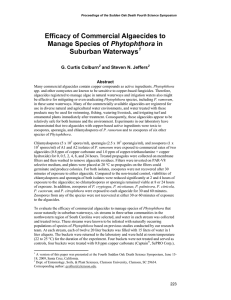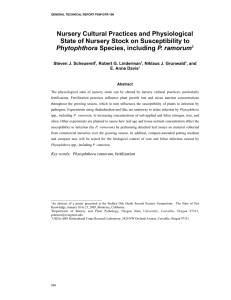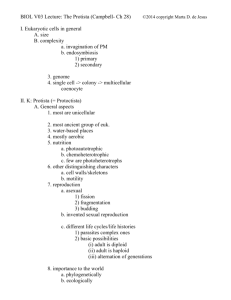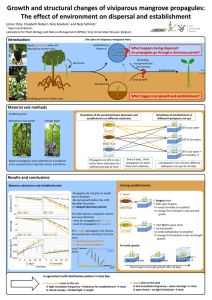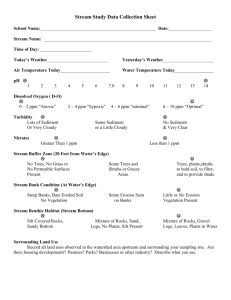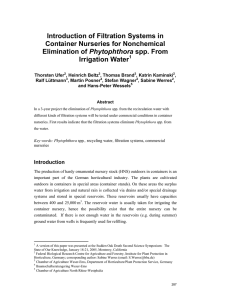Phytophthora Throughout the Year With Algaecides Inga M. Meadows,
advertisement
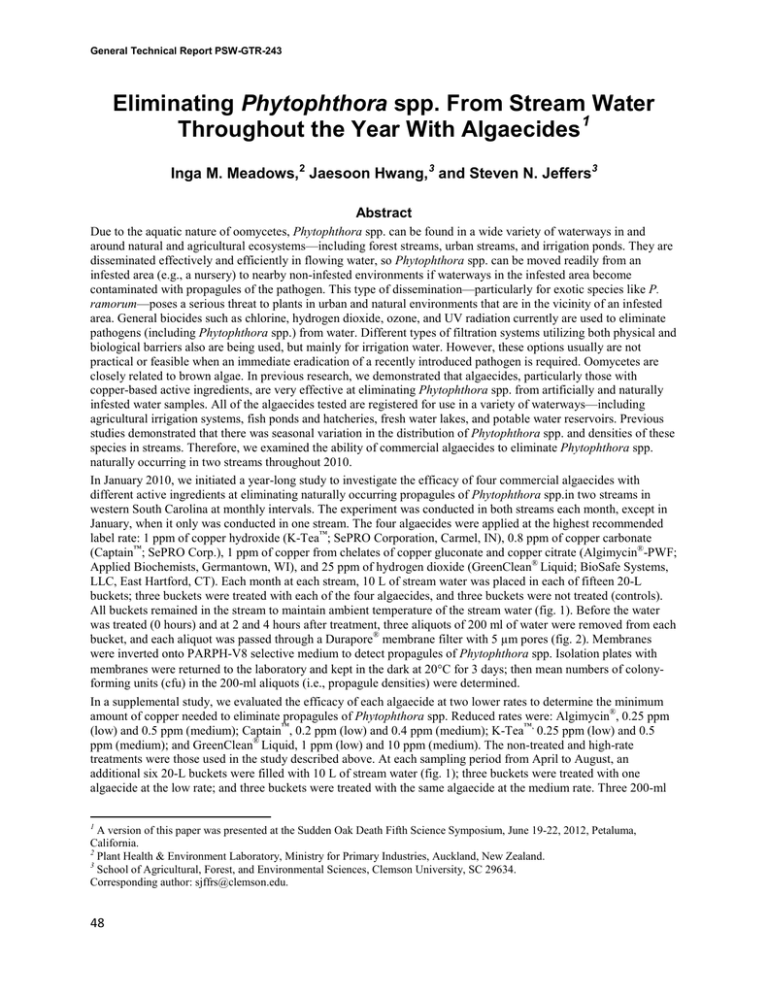
General Technical Report PSW-GTR-243 Eliminating Phytophthora spp. From Stream Water Throughout the Year With Algaecides 1 Inga M. Meadows, 2 Jaesoon Hwang, 3 and Steven N. Jeffers3 Abstract Due to the aquatic nature of oomycetes, Phytophthora spp. can be found in a wide variety of waterways in and around natural and agricultural ecosystems—including forest streams, urban streams, and irrigation ponds. They are disseminated effectively and efficiently in flowing water, so Phytophthora spp. can be moved readily from an infested area (e.g., a nursery) to nearby non-infested environments if waterways in the infested area become contaminated with propagules of the pathogen. This type of dissemination—particularly for exotic species like P. ramorum—poses a serious threat to plants in urban and natural environments that are in the vicinity of an infested area. General biocides such as chlorine, hydrogen dioxide, ozone, and UV radiation currently are used to eliminate pathogens (including Phytophthora spp.) from water. Different types of filtration systems utilizing both physical and biological barriers also are being used, but mainly for irrigation water. However, these options usually are not practical or feasible when an immediate eradication of a recently introduced pathogen is required. Oomycetes are closely related to brown algae. In previous research, we demonstrated that algaecides, particularly those with copper-based active ingredients, are very effective at eliminating Phytophthora spp. from artificially and naturally infested water samples. All of the algaecides tested are registered for use in a variety of waterways—including agricultural irrigation systems, fish ponds and hatcheries, fresh water lakes, and potable water reservoirs. Previous studies demonstrated that there was seasonal variation in the distribution of Phytophthora spp. and densities of these species in streams. Therefore, we examined the ability of commercial algaecides to eliminate Phytophthora spp. naturally occurring in two streams throughout 2010. In January 2010, we initiated a year-long study to investigate the efficacy of four commercial algaecides with different active ingredients at eliminating naturally occurring propagules of Phytophthora spp.in two streams in western South Carolina at monthly intervals. The experiment was conducted in both streams each month, except in January, when it only was conducted in one stream. The four algaecides were applied at the highest recommended label rate: 1 ppm of copper hydroxide (K-Tea™; SePRO Corporation, Carmel, IN), 0.8 ppm of copper carbonate (Captain™; SePRO Corp.), 1 ppm of copper from chelates of copper gluconate and copper citrate (Algimycin®-PWF; Applied Biochemists, Germantown, WI), and 25 ppm of hydrogen dioxide (GreenClean® Liquid; BioSafe Systems, LLC, East Hartford, CT). Each month at each stream, 10 L of stream water was placed in each of fifteen 20-L buckets; three buckets were treated with each of the four algaecides, and three buckets were not treated (controls). All buckets remained in the stream to maintain ambient temperature of the stream water (fig. 1). Before the water was treated (0 hours) and at 2 and 4 hours after treatment, three aliquots of 200 ml of water were removed from each bucket, and each aliquot was passed through a Durapore® membrane filter with 5 µm pores (fig. 2). Membranes were inverted onto PARPH-V8 selective medium to detect propagules of Phytophthora spp. Isolation plates with membranes were returned to the laboratory and kept in the dark at 20°C for 3 days; then mean numbers of colonyforming units (cfu) in the 200-ml aliquots (i.e., propagule densities) were determined. In a supplemental study, we evaluated the efficacy of each algaecide at two lower rates to determine the minimum amount of copper needed to eliminate propagules of Phytophthora spp. Reduced rates were: Algimycin®, 0.25 ppm (low) and 0.5 ppm (medium); Captain™, 0.2 ppm (low) and 0.4 ppm (medium); K-Tea™, 0.25 ppm (low) and 0.5 ppm (medium); and GreenClean® Liquid, 1 ppm (low) and 10 ppm (medium). The non-treated and high-rate treatments were those used in the study described above. At each sampling period from April to August, an additional six 20-L buckets were filled with 10 L of stream water (fig. 1); three buckets were treated with one algaecide at the low rate; and three buckets were treated with the same algaecide at the medium rate. Three 200-ml 1 A version of this paper was presented at the Sudden Oak Death Fifth Science Symposium, June 19-22, 2012, Petaluma, California. 2 Plant Health & Environment Laboratory, Ministry for Primary Industries, Auckland, New Zealand. 3 School of Agricultural, Forest, and Environmental Sciences, Clemson University, SC 29634. Corresponding author: sjffrs@clemson.edu. 48 Proceedings of the Sudden Oak Death Fifth Science Symposium aliquots were assayed from each bucket at 0, 2, and 4 hours after treatment as described above. Each reduced rate was tested twice during the year, once in each stream. Propagules of Phytophthora spp. were detected in both streams in all months and in all non-treated water samples. In one stream, mean propagule densities in non-treated water at 0 hours ranged from 1.1 to 30 cfu (mean 18.6 cfu); 30 cfu was the maximum number that could be counted with accuracy, so actual densities may have been greater. In the other stream, mean propagule densities ranged from 1.2 to 24.8 cfu (mean 8.3 cfu). The three copper-based algaecides completely eliminated propagules of Phytophthora spp. from water at 2 hours after treatment, so no propagules were detected at either 2 or 4 hours. GreenClean® Liquid, an algaecide that does not have a copper-based active ingredient, was not as consistent and somewhat less effective. In one stream, propagules were detected in March (0.7 cfu) and May (2.6 cfu) at 2 hours after treatment and in May (1.6 cfu) and June (0.1 cfu) at 4 hours after treatment. In the other stream, propagules were detected in five monthly samples (0.8 to 2.5 cfu) at 2 hours after treatment and in four monthly samples (0.1 to 0.6 cfu) at 4 hours after treatment. Propagules were not detected in any other water sample treated with GreenClean® Liquid. In the supplemental study, reduced rates of the copper-based algaecides were as effective as the maximum rate at eliminating propagules of Phytophthora spp. from naturally infested stream water; no propagules were detected after treatment with the low and medium rates of the three copper-based algaecides. However, GreenClean® Liquid was not as effective; propagules were not completely eliminated by reduced rates, and propagule density was reduced significantly only by the medium rate. Therefore, lower rates of the copper-based algaecides appear to be effective at eliminating propagules of Phytophthora spp. from water, but GreenClean® Liquid was not effective when applied at the reduced rates used in this study. In summary, algaecides continue to show promise as management tools for eliminating propagules of Phytophthora spp. from naturally infested water. Figure 1—Twenty-one buckets, each containing 10 L of stream water treated with an algaecide or not treated (control), sitting in a stream to maintain ambient water temperature. Fifteen buckets were used to compare efficacy of four algaecides and a non-treated control, and six buckets were used to evaluate reduced rates of one algaecide. Three replicate buckets were used for each treatment, and buckets were arranged in a completely randomized design. 49 General Technical Report PSW-GTR-243 Figure 2—Each month, all water sub-samples were processed at the stream site to maintain sample integrity and prevent potential propagule degradation during storage and transit. 50
